![]()
![]()
![]()
Use LEFT and RIGHT arrow keys to navigate between flashcards;
Use UP and DOWN arrow keys to flip the card;
H to show hint;
A reads text to speech;
42 Cards in this Set
- Front
- Back
|
Overall function of the Nervous System
|
Receive sensory input, intergration of sensory info & motor responses, control muscles and glands, maintain homeostasis, and perform higher fxns (ex. attention, comprehension, problem solving, memory and emotion).
|
|
|
CNS
|
Brain (cerebral hemispheres, diencephalon, cerebellum & brainstem) and spinal cord. Important for analysis and integration of sensory and motor info, other "high fxns" such as emotion, memory, reasoning, etc.
|
|
|
PNS
|
Cranial nerves and spinal nerves, both include sensory and motor (somatic and autonomic) nerves.
|
|
|
The Baroreceptor reflex
|
An example of sensory-motor integration. Nerve endings in the great vessels that monitor BP send info to the brainstem where it is analyzed and an appropriate response motor response is initiated. If BP is too low, the autonomic motor response from the CV center in the brainstem will be to increase sympathetic activity to the CV system.
|
|
|
Major structures of the CNS
|
Spinal cord
Brainstem (medulla, pons, and midbrain) Cerebellum Diencephalon (hypothalamus and thalamus) Cerebrum (frontal, parietal, temporal, occipital lobes) |
|
|
Spinal cord
|
31 pairs of nerves enter and exit at various levels
Motor neurons exit through ventral Sensory neurons exit through dorsal Gray matter forms the horns, white matter forms around the horns. |
|
|
Gray matter
|
Where neural and glial cell bodies are located, clusters of cell bodies make the darker color
|
|
|
White matter
|
Made up of axonal tracts (white b/c of myelination)
|
|
|
Brainstem
|
![3 divisions: midbrain, pons, medulla
10 of 12 CNs arise from the brainstem [other 2 arise in nasal epithelium (CNI) and the retina (CNII)]](https://images.cram.com/images/upload-flashcards/70/63/82/2706382_m.jpg)
3 divisions: midbrain, pons, medulla
10 of 12 CNs arise from the brainstem [other 2 arise in nasal epithelium (CNI) and the retina (CNII)] |
|
|
Medulla
|
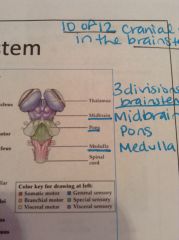
Cardiovascular and respiratory centers, reflexes (coughing, vomiting, swallowing)
|
|
|
Pons
|
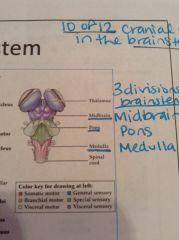
Balance and posture (vestibular centers), respiratory center, relays nerves b/t cerebrum and cerebellum
|
|
|
Midbrain
|

Controlling eye movements, nuclei for relaying visual and auditory info
|
|
|
Cerebellum
|
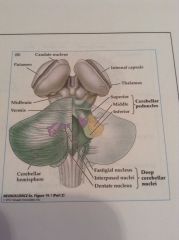
Foliated hemispheres attached to dorsal surface of the brainstem. Responsible for motor fxns like coordination (including head and eye), planning and execution, and posture. Also sensory discrimination b/t objects of different textures.
|
|
|
Inputs into the cerebellum
|
Proprioception from spine (orientation of body parts), motor info from cerebral cortex, and vestibular info from inner ear.
|
|
|
Diencephalon
|
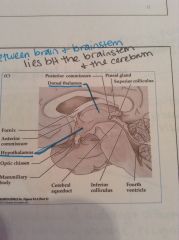
Made up of the hypothalamus and thalamus, b/t the cerebrum and the brainstem
|
|
|
Thalamus
|
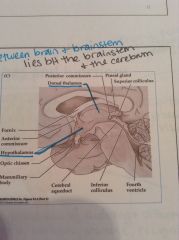
Sensory and motor relay to and from cerebrum
|
|
|
Hypothalamus
|
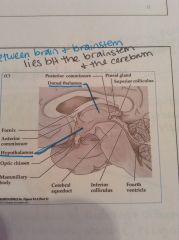
Endocrine fxn and homeostatic control (body temp, food intake, and water balance)
|
|
|
Cerebrum
|
R & L hemispheres w/connecting commissures. Gray matter in the cortex and nuclei, white matter in the underlying axonal tracts and commissures.
|
|
|
Cerebrum fxns
|
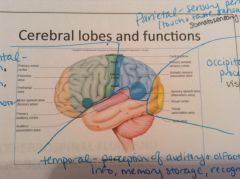
Perception, higher motor fxns (fingers and hands), cognition, memory, language and emotion
4 lobes: frontal, parietal, temporal and occipital |
|
|
Frontal lobes
|
Motivation, mood, aggression, controlling voluntary motor fxns
|
|
|
Parietal lobes
|
Sensory perception (touch and taste sensation), somatosensory
|
|
|
Temporal lobes
|
Perception of auditory and olfactory info, memory storage, recognition, comprehension
|
|
|
Occipital lobes
|
Processing visual info
|
|
|
Primary cortices
|
Direct processing, fewer synapses, direct perception
|
|
|
Association cortices
|
Complex processing, numerous synapses, integration (unimodal and multimodal) for purposeful actions
|
|
|
Deep nuclei of the cerebrum
|
Clusters of neural cell bodies (gray matter)
Basal ganglia, hippocampus, amygdala |
|
|
Basal ganglia
|
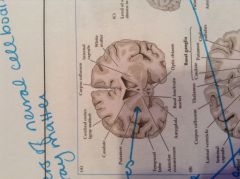
Regulates motor fxn, input from all cerebral lobes, projects to the frontal cortex via thalamus
|
|
|
Hippocampus
|
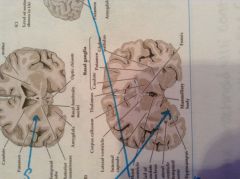
In the temporal lobe, responsible for memory consolidation
|
|
|
Amygdala
|
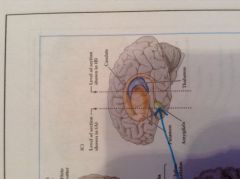
In the temporal lobe, responsible for emotional processing, projects to the hypothalamus, influences autonomic fxns (controlling body responses to emotions, ex. Fear --> increased HR)
|
|
|
Cerebrospinal fluid
|
Functions to cushion and remove debris. ~150ml/day.
Flows from choroid plexus into ventricles and subarachnoid spaces. Emptied into venous blood at the sagittal sinus via arachnoid granulations. |
|
|
Where do you get a sample of CSF?
|
From the subarachnoid space in the lumbar cistern
|
|
|
How is CSF recycled?
|
The endothelial cells of the arachnoid villi contain vesicular passages directly through the cells that allows the CSF to flow freely into the blood.
|
|
|
How is CSF produced?
|
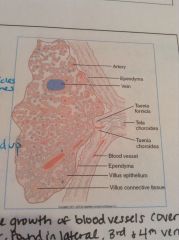
~500 ml/day. 2/3rds by the choroid plexus, 1/3 by the ependymal surfaces lining ventricles and arachnoid membrane. Secretion is driven by Na movement across epithelium, followed by osmosis, proteins excluded.
|
|
|
Choroid plexus
|
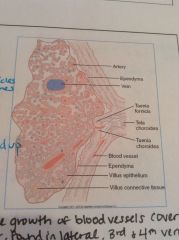
Cauliflower like growth of blood vessels covered by a single epithelial layer, found in lateral 3rd and 4th ventricles.
|
|
|
CSF production/drainage balance
|
Volume produced must match volume drained into venous blood, otherwise pressure will build up.
|
|
|
Hydrocephalus
|
May be caused by blockage of flow in ventricles, subarachnoid space, or across arachnoid villi. Causes the ventricles to swell and compress brain tissue. Very dangerous!
|
|
|
Composition of CSF
|
Resembles interstitial fluid. Has about same amount of Na, Cl, HCO3, osmolarity. Low in protein and cholesterol, b/c they're too large to pass through epithelial surfaces at the site where the CSF is being produced.
|
|
|
Blood-brain barrier
|

Very tight barrier, brain cells are sensitive to composition of interstitial fluid surrounding them and toxins, cannot be allowed to cross the walls of the capillaries.
|
|
|
What forms the BBB?
|

Tight junctions of endothelial cells and astrocyte foot processes.
|
|
|
What can cross the BBB?
|
Only lipid-soluble substances diffuse across freely. Hydrophilic substances must have specific transporters in endothelial cell membrane of capillary wall and astrocytes to get through.
|
|
|
Leakiness of BBB
|
May result from infection, inflammation, and tumors. Toxins may be able to leak out into the brain tissue
|
|
|
Drugs and the BBB
|
Many drugs are specifically designed to be hydrophilic so that they will NOT pass into the brain through the BBB. Ex, older antihistamines were slightly lipophilic and would get into the brain tissue and cause drowsiness, new antihistamines are made hydrophilic.
|

